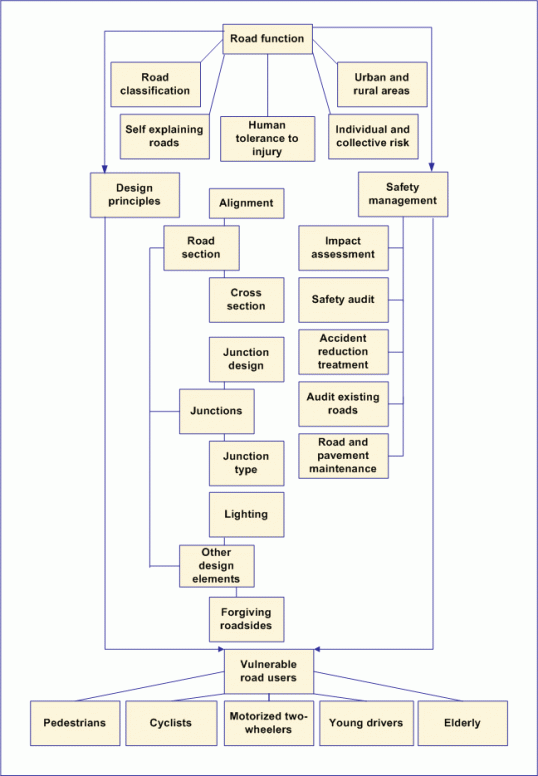Roads
This text on roads, reviews the scientific studies on the magnitude and nature of the safety problem, the contributing accident factors, and the effectiveness of countermeasures.
For information on the development of casualty frequencies and accident circumstances over the period 1996-2005 per European country, please consult the Basic Fact Sheet Motorways, the Basic Fact Sheet Urban areas and the Basic Fact Sheet Junctions on the Data section of the website.
Diagram & Summary
Many of the basic principles for good road design were developed up to 40 years ago, and are still valid today. Although further refinements have been explored since then, there still remains uncertainty about relationships associated with design details and recent engineering innovations.
Designing for road function
Roads should be designed to cater for a defined function, separating roads for through traffic, roads for distribution of traffic within an area, and local access roads. By adopting a consistent and clearly differentiated design for each function group, driver's subjective assessment of risk can be better actual risk. This in turn encourages road user behaviour consistent with the safety standard of the road. The same general functional management principles should be applied in both urban and rural networks. Road infrastructure should be designed taking account of the same injury tolerance criteria as those developed for vehicle occupant protection and pedestrian impacts, so that roads and vehicles together provide an effective safety system.
Getting initial safety design principles right
Accident rates vary with road alignment, road width, roadside and median treatment, and with choice of junction type and design. Appropriate design choices are needed for roads serving each function to minimize the number of accidents likely to occur and to mitigate injury severity, particularly on higher speed roads.
Managing safety of roads through their whole life
Safety management should start with a safety impact assessment before a decision is made to site a new road. Safety audit at the design and construction stage is needed to ensure all aspects of detailed design that might affect safety are addressed. Once the road is built, highway authorities have a responsibility to ensure its safe operation. This is best done through a combination of accident investigation and on-road inspection to enable cost effective remedial programmes to be developed; many tools exist to support these activities. The skid resistance of a road surface is an important road safety factor; both micro-texture and macro-texture of the surface play a part.
Roads need to cater safely for all users
The design of roads should be adapted to the limitations of human capacity. Among pedestrians the young and the elderly are most at risk. Risk to cyclists varies substantially between countries mainly reflecting the infrastructure provided for them and the motorized traffic levels they interact with. Risk for motorized two wheelers is particularly high and solutions are needed to minimize the severity of injuries resulting from their impact with roadside furniture. Road designers should recognize the diminished physical and cognitive capabilities of elderly road users.

